Cherry Audio
Showing 1–20 of 28 results
Showing 1 - 20 out of 20
Page 0 out of 0
| Rating | Image | Product | Price |
|---|---|---|---|
|
4.88 SOUND QUALITY FEATURES VALUE FOR MONEY EASE OF USE |
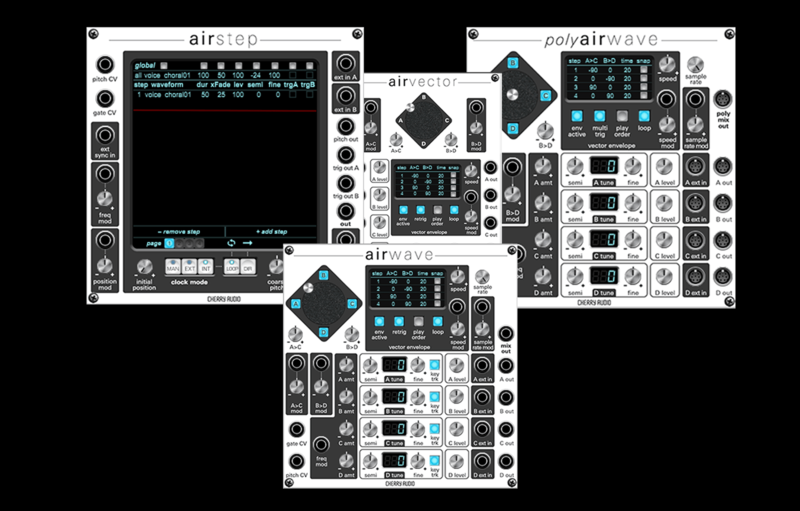 |
Vector BundleVector Bundle includes the exciting AirWave, Poly AirWave, AirVector, and AirStep modules. These incredible modules simply have to be heard to be believed. Combining the power of vector synthesis, sample playback, and wave sequencing with raw modular synthesis, these modules deliver a vast new palette of dynamically changing tone colours to Voltage Modular. AirStep brings the sought-after sound of wave sequencing to the modular environment. With over 300 onboard PCM sample waves and massively flexible modulation, trigger, and sync options, AirStep takes wave sequencing synthesis to an entirely new level. Its advanced interfaces tremendously simplify the creation of complex wave sequences. AirVector is a joystick-controlled quad vector mixer, usable with any Voltage Modular audio signals. Its flexible modulation options and super easy-to-configure vector envelope section make it must-have for creating evolving timbres. AirWave is fantastically powerful joystick-controlled quad vector digital oscillator, featuring over 200 looped PCM sample waves. Its flexible modulation options and super easy-to-configure vector envelope section make it must-have for creating evolving timbres. Separate outs for each wave and a sample rate knob enable easy creation of radical and unearthly timbres. Poly AirWave delivers the same rich, dense, evolving soundscapes of our AirWave module in a fully polyphonic version. A fantastically powerful joystick-controlled quad vector digital oscillator, Poly AirWave features over 200 looped PCM sample waves. Its flexible modulation options and super easy-to-configure vector envelope section make it must-have for creating evolving timbres. Separate outs for each wave and a sample rate knob enable easy creation of radical and unearthly timbres. Also included are a selection of incredible presets that show off the vast array of sounds available with the Vector Bundle. Note: These presets are designed to work with modules from the Voltage Modular Core package. Mac
Windows
Voltage Modular is cross-platform for Windows and OSX in AU, VST, VST3, and Pro Tools AAX formats, and also runs standalone on both platforms. User patches and cabinets are freely exchangeable across platforms. |
Price History: Vector Bundle 39.00 $ |
|
4.86 SOUND QUALITY FEATURES VALUE FOR MONEY EASE OF USE |
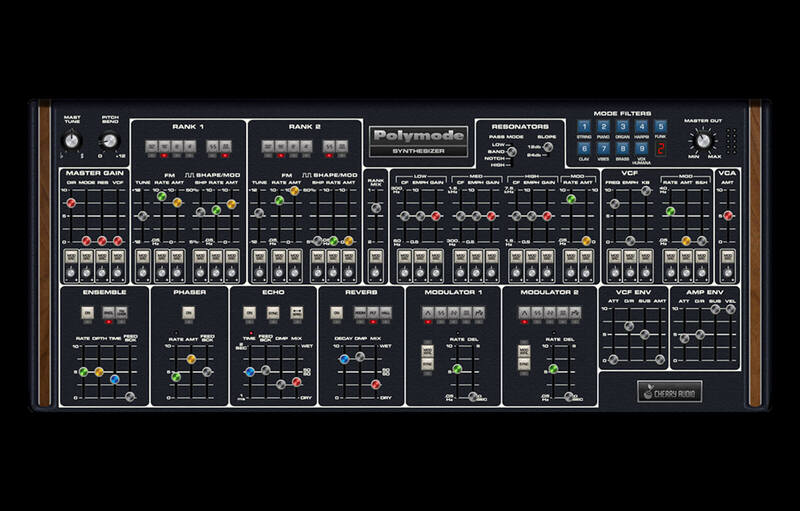 |
Polymode SynthesizerThe Massive Poly Sound Machine Polymode is inspired by the groundbreaking Moog Polymoog synthesizer. One of the world’s first polyphonic synthesizers, its unique multiple parallel filter implementation and mod routings give it a sound like no other synth. And though the original Polymoog sounded incredible, it could be challenging to operate and was prone to breakdowns. Cherry Audio’s Polymode sidesteps all of the drawbacks of the original instrument and massively expands its capabilities. With a streamlined user interface and immense modulation capabilities, Polymode sets a new standard for animated, sonically evolving string, pad, and choral tones. Polymode Synthesizer Features:
Polymode Synthesizer is available in AU, VST, VST3, AAX, and Standalone formats. macOS Requirements: macOS 10.9 or above, 64-bit required. Quad-core computer with 8GB of RAM recommended. Native Apple M1 processor support. Windows Requirements: Windows 7 or above, 64-bit required. Quad-core computer with 8GB of RAM recommended. |
Price History: Polymode Synthesizer 39.00 $ |
|
4.78 SOUND QUALITY FEATURES VALUE FOR MONEY EASE OF USE |
 |
Eight Voice SynthesizerTaming A Classic Beast Our most ambitious instrument to date, Cherry Audio’s Eight Voice polyphonic synthesizer meticulously emulates the immense sound of the Oberheim Eight Voice, one of the world’s rarest and most desirable vintage instruments. Predating modern microprocessor control, its eight independent dual-oscillator voice modules could be challenging to program. Cherry Audio Eight Voice’s unique Voice Link controls allow simple and powerful grouping of voice module controls, eliminating individually setting each module’s controls when homogenous poly sounds are desired. Focus buttons allow instant enlargement of any section of the user interface, making sound programming a breeze, and massively flexible keyboard assign modes enable endless mono and poly keyboard zoning and layering options. All in all, we’ve transformed the original’s daunting user interface into a fun and inviting mondo poly synth experience. Above all, Eight Voice knocks it out of the park with an incredibly accurate and huge sound, courtesy of award-winning synth designer, Mark Barton’s (MRB) circuit-correct recreation of the magnificent Oberheim state-variable filter. Eight Voice also includes a feature-packed eight-step “mini” sequencer, and high quality modulation delay and reverb effects. Cherry Audio’s Eight Voice is truly bursting with unique sound possibilities at an unbelievably affordable price! Eight Voice Synthesizer Features:
Eight Voice Synthesizer is available in AU, VST, VST3, AAX, and Standalone formats. Available in AU, VST, VST3, AAX, and Standalone formats. macOS Requirements: macOS 10.9 or above, 64-bit required. Quad-core computer with 8GB of RAM recommended. Native Apple M1 processor support. Windows Requirements: Windows 7 or above, 64-bit required. Quad-core computer with 8GB of RAM recommended. |
Price History: Eight Voice Synthesizer 39.00 $ |
|
4.78 SOUND QUALITY FEATURES VALUE FOR MONEY EASE OF USE |
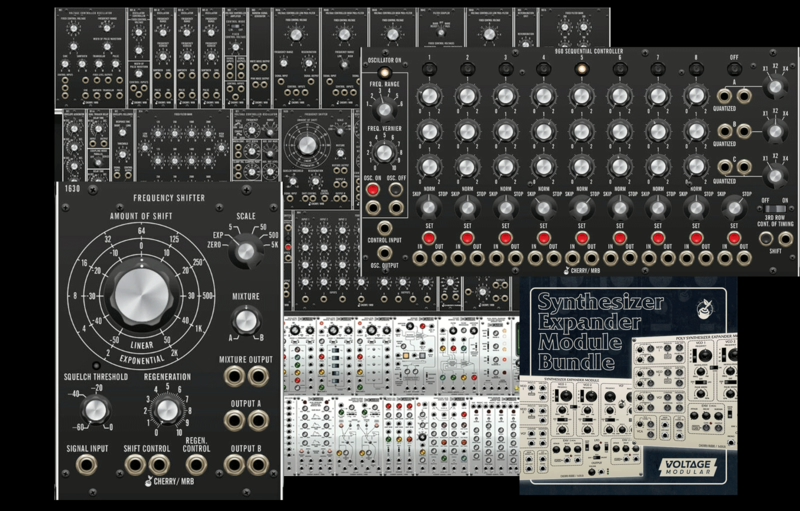 |
Cherry Audio Year Three CollectionImportant Note: Voltage Modular is required in order to use this product. Cherry Audio Year Three Collection for Voltage Modular assembles all of Cherry Audio’s killer “high-end” Cherry Audio/MRB brand modules from Voltage Modular’s third year including VM900 Collection, VM2500 Collection and Synthesizer Expander Module Bundle, at huge savings over the individual purchase prices. VM900 Collection (for Voltage Modular) With the sound, look, and feel that started it all, the Cherry Audio/MRB VM900 Collection delivers the audio and visual experience of the legendary 1960s and 1970s-era Moog 900-series modules with spine-tingling impact and accuracy. Every detail has been expertly reproduced, for a virtual window into the halcyon days of early analog synthesis. Award-winning synth designer Mark Barton’s (MRB) proprietary DSP coding reproduces each and every sonic nuance with unprecedented accuracy. The VM900-series designs remain true to the originals and have not been altered or updated to reflect modern trends. Panel layouts and operation have been preserved in order to present a one-to-one early analog experience like no other. From oscillator drift to warm mixer overdrive to painstakingly reproduced panel art, it’s all there. And with 27 modules, the Cherry Audio/MRB VM900 Collection represents all of the commonly produced 900-series modules, including the early 901-style and later 921-style oscillators, both in single and “ABBB” grouped module versions. The coveted 904 ladder filter is also included in lowpass and highpass versions as well as an “ABC” combo version with the 904C Coupler module for endless filter curve flavours. The famous CP3 Mixer includes both early and later circuit styles for vintage-correct overdrive or purer tones. Cherry Audio also included a unique Keyboard/VCO Interface module that allows three-voice chordal “paraphonic” operation and three highly-adjustable independent glides.A classic modular system couldn’t possibly be complete without the 960-series sequencer. Originally used by Klaus Schulze, Tangerine Dream, and Kraftwerk, this is the eight-stage step sequencer that set the standard, and Cherry Audio replicated it exactly (along with the accompanying 962 Sequential Switch module). Actually, Cherry Audio added one extra feature – a 1/12 V quantized output for each sequence row, which greatly simplifies the creation of chromatic melodies. Perhaps the star of the show is the VM1630 Frequency Shifter. Notoriously difficult to properly emulate in software and hardware, Mark Barton’s advanced DSP replicates every nuance of this incredible-sounding module. From subtle vibrato, to wild phaser-like tones, to ring modulation-style alien swoops and metallic clangs, the VM1630 absolutely nails the jaw-dropping sound of this rare and desirable classic. The Cherry Audio/MRB VM900 Collection is simply a “must-have” module set for all purveyors of vintage analog synthesis. It’s a no-brainer for existing Voltage Modular users, with no operational limitations. The Cherry Audio/MRB VM900 Collection for Voltage Modular includes all 27 modules, plus hundreds of presets and variations. VM2500 Collection (for Voltage Modular) Cherry Audio and MRB are thrilled to announce the release of the VM2500 Collection, an incredible set of 21 modules for the Voltage Modular virtual modular synthesizer platform that painstakingly recreate the coveted, and incredibly rare, vintage ARP 2500 modular synthesizer. Tonus Systems was founded in 1968 by engineer and businessman Alan R. Pearlman, with the “ARP” brand taken from his initials. At the time, Moog was the only other company producing voltage-controller analog synthesizers. Using cutting-edge space-race technology, Pearlman set out to improve upon existing Moog designs with the release of the massive 2500 series modular synths in 1970. Because of their inherent temperature sensitivity, the tuning stability of early Moog oscillators wasn’t especially good. ARP was able to greatly increase tuning stability by encasing the oscillator modules in blocks of epoxy (with the added bonus of concealing the design from competitors and making servicing next to impossible). ARP also sought to eliminate the maze of panel-concealing patch cables inherent to Moog modulars. They accomplished this via a “matrix-patching” system – all module control and audio connections were internally connected to numerous twenty-position (!) slide switches above and below the single row of modules. Though the matrix switch system succeeded in eliminating cable-clutter, it was subject to crosstalk issues as the number of interconnected module signals increased, as well as additional issues as the switch contact surfaces wore out. In its day, 2500 was conceived as an innovative, price-is-no-object technological tour-de-force. Its designers used the very best components available to them, including high-fidelity op-amps for superior sound quality, cutting-edge logic chips for the sequencer modules, and more. As a result, 2500 remains one of the fattest, punchiest analog synths ever made, but as a result of its sky-high price, only about 100 were produced during its roughly ten-year production run. A Rarity Lives On Cherry Audio and MRB have collaborated to deliver the 2500’s unique module features, stunning sound quality, and overall user experience to the Voltage Modular platform. All 18 modules originally produced for the ARP 2500 system have been recreated in perfect detail, plus a couple that were planned but never produced (including a full-function oscilloscope and a spring reverb) and a mixer module that never existed, but should have! Cherry Audio eliminated the matrix-switch I/O scheme and replaced all connections with standard CV jacks, and added bi-polar CV attenuators to all modulation inputs for full compatibility with all Voltage Modular modules. But most importantly, the tremendous analog sound and unique features of the original modules have been retained in their entirety, with a few small tweaks to improve the practicality of these 50-year-old designs. The recreation of the 2500 modules was a team effort, combining Cherry Audio’s extensive design experience with award-winning synth designer Mark Barton’s (MRB) DSP coding sorcery. The result is a virtual time machine of fat, impactful early electronic music history for the ears! An Incredibly Affordable Legend It has been estimated that there are roughly 50 functional ARP 2500 instruments remaining in the world, and these currently trade in the six-figure area (if you can ever find one for sale). The Cherry Audio/MRB VM2500 Collection for Voltage Modular includes all 21 modules, plus hundreds of presets and variations. Synthesizer Expander Module Bundle (for Voltage Modular) Cherry Audio is thrilled to announce the release of the Synthesizer Expander Module Bundle for Voltage Modular, which includes both the Synthesizer Expander Module and the Poly Synthesizer Expander Module, along with 50 presets. These modules meticulously emulate the immense sound of the classic Oberheim Synthesizer Expander Module, aka the “SEM.” Originally released in 1974, the keyboardless, monophonic SEM module was intended as a companion to the Oberheim DS-2, one of the earliest digital sequencers. Soon thereafter, Oberheim realized they could interface a digitally scanned keyboard, mount the whole mess in a big box, and create polyphonic synthesizers, beginning with the Two Voice, followed by the Four Voice, and finally the beastly Eight Voice. Though it was a relatively simple monosynth, the SEM sounded fantastic, and had a tone quality very different than the common fuzzy, fat Moog sound, thanks to its 12 dB/oct state-variable filter. With lowpass, bandpass, highpass, and notch modes, this flexible filter was the star of the show. Cherry Audio has carefully modeled every detail of the original SEM module, while adding new features, including a noise source and a square-wave LFO option. Cherry Audio precisely recreated the SEM’s unique filter experience, courtesy of a detailed emulation created by award-winning synth designer Mark Barton (MRB). Cherry Audio also added an extensive complement of patch points for full Voltage Modular integration. Finally, the Poly Synthesizer Expander Module makes analog rock-and-roll dreams come true with a full sixteen voices of vintage polysynth madness! Mac
Windows
|
Price History: Cherry Audio Year Three Collection 129.00 $ |
|
4.78 SOUND QUALITY FEATURES VALUE FOR MONEY EASE OF USE |
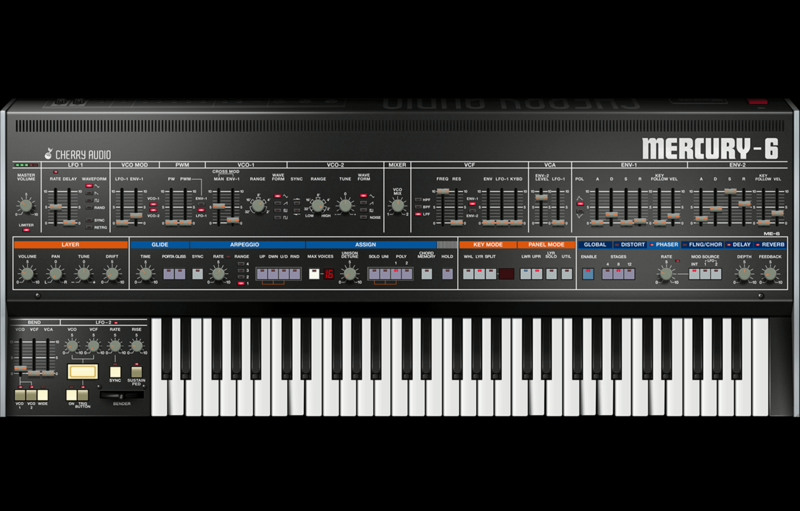 |
Mercury-6The Sleeper Has Awakened Mercury-6 is a meticulous recreation of the Jupiter-6 analog polyphonic synthesizer, initially released in 1983. Sandwiched between the earlier Jupiter-4 and Jupiter-8 models in name only, the sophisticated Jupiter-6 has sometimes been considered a sleeper release. These days, it has persevered to become one of Roland’s most notable and coveted classic synthesizers due to its distinctive dark and complex character. If you’ve long yearned to explore the Jupiter-6, you’ll love Mercury-6! The Year Everything Changed Released in 1983 as a more affordable alternative to the flagship eight-voice Jupiter-8, the six-voice Jupiter-6 nevertheless staked out an essential position in the history of analog polysynths. Though similar in appearance and feature set, the Jupiter-6 sounded considerably different from the Jupiter-8. The Jupiter-6’s versatile filter design lent a more aggressive sound than previous Jupiters, making it a natural for cutting-edge techno and electro styles. The Jupiter-6 VCOs supported multiple simultaneous waveforms, and its two LFOs and oscillator cross mod capabilities provided extensive modulation possibilities. Its earthshaking solo and poly unison modes enabled massive lead and bass sounds, and it was one of the first synthesizers to include the then-new MIDI protocol. However, the cost-cutting in the Jupiter-6 design resulted in some disadvantages. Audio output was mono only, and it was limited to six-voice polyphony, hampering the potential of its split keyboard feature. And its timing was ill-fated with the release of Yamaha’s revolutionary DX7 the same year. But in a testament to the Jupiter-6’s staying power over the decades, its popularity grew in genres such as big beat, house, and techno. As a result, the original hardware is still in demand today. Mercury-6: Twice As Nice at a Fraction of the Price Cherry Audio’s Mercury-6 captures all that is exceptional in this classic and boosts the extraordinary feature set and functionality for today’s DAW production and workflow. We’ve added velocity sensitivity, improved the split mode, and added a layer mode capable of stacking two different sounds simultaneously with per-layer stereo panning, detuning, and sustain. A panel control lets users easily select and navigate between these layers and includes a utility function for exchanging settings between the lower and upper layers, or even between presets. And with polyphony extended to 16 notes, Mercury-6 won’t easily run out of voices. We’ve reproduced the arpeggiator, including the hidden Up/Down modes of the original, and augmented it by adding a Random mode and MIDI tempo sync. A chord memory mode enables multiple notes to be stored and played back with a single key. We’ve improved the functionality of the LFOs with a retrigger for LFO-1 and an always-on option for LFO-2, both syncable to MIDI tempo. We’ve also introduced an integrated studio-quality effects panel with brilliant-sounding distortion, phaser, flanger/chorus, delay, and reverb. With additional touches such as per-layer drift control, over 500 expertly designed presets, and flexible MIDI mapping, Cherry Audio’s Mercury-6 brings the authentic Jupiter-6 experience 40 years into the future. Mercury-6 Features
AU, VST, VST3, AAX, and standalone formats macOS Requirements: 10.13 or above. macOS 13 Ventura supported. 64-bit required. Native Apple M1 processor support, including Apple M1 Ultra. 3.4 GHz Quad-Core or M1 CPU with 8GB of RAM is recommended. Windows Requirements: Windows 7 or above (including Windows 11), 64-bit required. Quad-core computer with 8GB of RAM is recommended. Internet connection required for product activation. |
Price History: Mercury-6 49.00 $ |
|
4.76 SOUND QUALITY FEATURES VALUE FOR MONEY EASE OF USE |
 |
QuadraVintage Synthesis, To The Fourth Power Quadra is a super-accurate and immensely improved emulation of the ARP Quadra synthesizer, originally released in 1978 – a rare and coveted “unicorn” instrument in the synthesizer world, reproduced for the first time as a virtual instrument. Each of its four sections is independently assignable to any region of the keyboard for endless splitting and layering flexibility. The awkward patch storage has been replaced with Cherry Audio’s extensive, unlimited patch browsing system. The overall sound quality has been improved for a richer and fatter tone. And not only did Cherry Audio make a killer emulation of the aforementioned onboard phaser effect, but they also added a stereo chorus/flanger, a syncable echo, and studio-quality reverb – all individually routable for unprecedented effects flexibility. All About That Bass A fat, monophonic bass section for punchy low end, plus “Strings Bass” for string machine-style orchestral richness. Classic String Synthesizer A rich string section that beautifully reproduces the classic string ensemble instruments of the 70s, including a dedicated two-band EQ. Flexible Poly Synthesizer A super-improved version of the original, including saw, variable pulse, “spike,” and “hollow” waveforms, expanded range, and a drift button for organic tone. Screaming Lead Synth A powerful, feature-packed, dual-oscillator lead synth, including ramp, pulse, sine, triangle, and noise waves, LFO- or envelope-controlled pulse-width modulation, two-voice split mode, independent oscillator portamento controls and more. Features
Mac
Windows
|
Price History: Quadra 49.00 $ |
|
4.76 SOUND QUALITY FEATURES VALUE FOR MONEY EASE OF USE |
 |
MemorymodePolyphonic Legend Memorymode is based upon one of the very best-sounding polyphonic programmable analog synthesizers of the 80s – the legendary Memorymoog synthesizer. Released in 1982, the Memorymoog raised the sonic bar with its lush, powerful analog sound. Memorymode expands upon the original without compromising any of the sound or functionality that made it great, and does away with the reliability, maintenance, and tuning issues of the original. The user interface has been streamlined and simplified, updating the original instrument’s numeric-keypad-and-command-numbers with fast, simple-to-use pop-up menus and an improved value display window. Memorymode delivers a one-two punch of huge tonality, with super-accurate replications of the original three-oscillator voice architecture and a precise implementation of the coveted ladder filter circuit. Further contributing to its famous hefty sound, Memorymode’s oscillator mixer gently overdrives when levels are cranked, just like the original. In addition to all of the voicing and modulation that made the original sound so great, we’ve added a number of creative and convenient features aimed at modern music makers. Memorymode’s LFO, arpeggio, and delay effects all feature one-button tempo sync, and filter and amplitude velocity sensitivity add a whole new layer of expressiveness. A unique Drift parameter allows continuously variable adjustment of tuning accuracy, from perfectly in tune, to aged and loose, or anywhere in between, and the Modern button brings Memorymode into the present with fattened bass and sparkling highs. Comprehensive MPE support is included for expressive controller performances, and Memorymode’s high-quality effects add the final polish to patches, including an earthy stereo phaser, a dreamy stereo ensemble, a flexible tempo-synced echo, and a lush reverb section. For those not inclined to program their own sounds, Memorymode includes over 600 stunning presets, created by a veritable dream team of industry-veteran synth programmers, and showcasing Memorymode’s immensely flexible voice architecture. Our all-star team of sound designers includes: Julian “J3PO” Pollack, an accomplished pianist and keyboardist, producer, and audio engineer. In addition to his thriving career as a jazz composer and performer, J3PO has created sound banks and presets for Clavia, Softube, and Dave Smith Instruments. Dave Polich, sound designer, music producer, and songwriter. He’s crafted sounds for major artists including Michael Jackson, Fleetwood Mac, and The Cure, and has created thousands of factory presets for synthesizer giants including Yamaha, Korg, Roland, and Dave Smith Instruments. Huston Singletary, a veteran sound designer, producer, film composer, and podcaster. He’s contributed sounds to an endless array of popular products by Toontrack, Izotope, Synthogy, Kilohearts, Roland, Alesis, Spectrasonics, and Ableton. Memorymode replicates the incredible sound and feel of the original instrument at a tiny fraction of the cost of a vintage original, delivering all the power and musicality of the Memorymoog at a price anyone can afford. Memorymode Features:
macOS Requirements:
Windows Requirements:
|
Price History: Memorymode 49.00 $ |
|
4.76 SOUND QUALITY FEATURES VALUE FOR MONEY EASE OF USE |
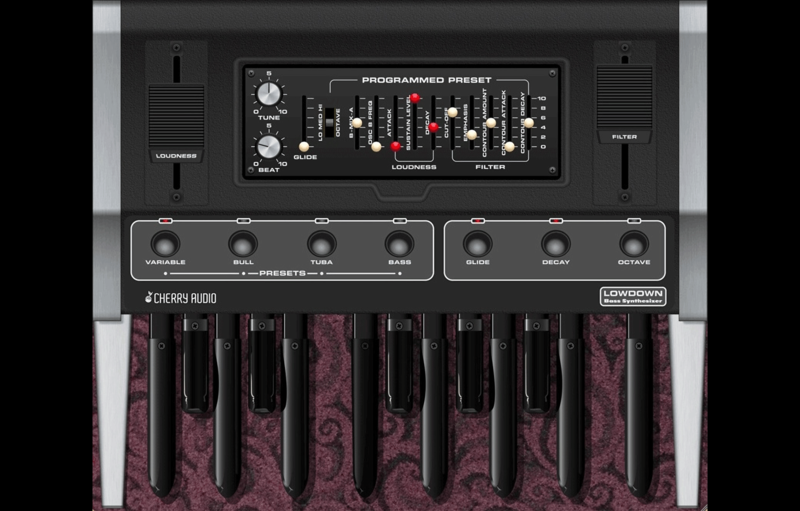 |
Lowdown Bass SynthesizerThe Fattest Floor Synth, Now on Desktop The Sound of Thunder The Lowdown Bass Synthesizer recreates the super-fat, room-rattling sounds of the most legendary dual-oscillator bass pedal synth ever made. Heard on countless prog-rock and new wave tracks in the 70s and 80s, this floor pedal monster comes to the desktop for the very first time. From the dual “constant-beat” oscillators to the girthy ladder filter, DSP wizard Mark Barton (MRB) has modeled every aspect of the original with exceptional accuracy. Get down to the ground with Lowdown! Get the Lowdown Outside of a handful of organ-oriented instruments, the original instrument was the first dedicated foot-controlled bass synthesizer, and with its colossal tone, unquestionably the best sounding. It was used by some of the top acts of 70s and 80s, including Rush, Yes, Genesis, U2, and The Police (check out the intro of “Don’t Stand So Close To Me” or Phil Collins’ “I Don’t Care Anymore.”) The original design used a Hz/oct oscillator scaling (as opposed to the more conventional volts/oct oscillator scaling), allowing oscillator detuning amount to remain constant across the keyboard by minimizing the phase cancellation that can happen when two oscillators play simultaneously. Along with a couple of other engineering tricks, this contributes to its beefy sound. In order to create Cherry Audio’s Lowdown, DSP and synthesis legend Mark Barton carefully analyzed the original’s synthesis circuits and precisely recreated them for a massive virtual bass experience like no other. We’re simply thrilled with the outcome of this fun and easy-to-use earth-moving bass experience and we hope you love it as much as we do! Features:
macOS Requirements
Windows Requirements
|
Price History: Lowdown Bass Synthesizer 29.00 $ |
|
4.74 SOUND QUALITY FEATURES VALUE FOR MONEY EASE OF USE |
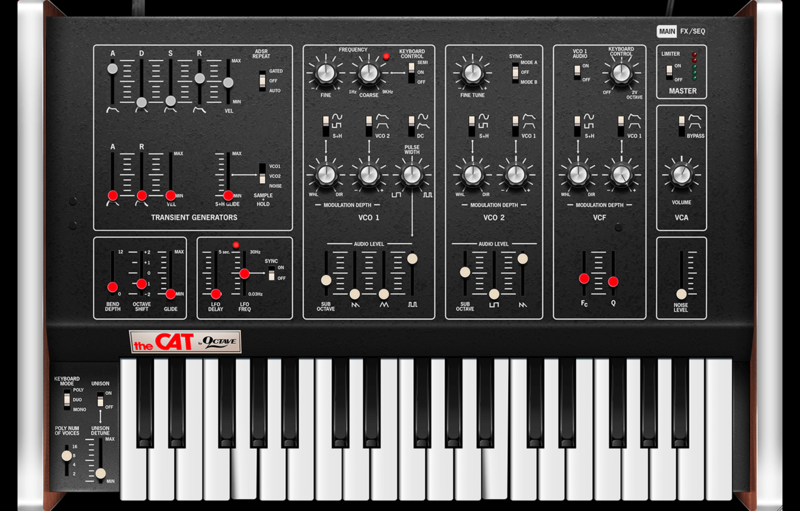 |
Octave CatA Ferocious New Breed Cherry Audio’s Octave Cat synthesizer emulates The CAT duophonic synthesizer unleashed by Octave Electronics in 1976. Developed in partnership with The CAT’s original designer, Octave Cat retains all the growl of the original hardware’s fat, savage sound and replicates its aggressive resonant filter. Octave Cat features the flexible modulation, screaming audio-range oscillator cross-mod, and fierce oscillator sync of the original hardware, and extends it with expanded polyphony, a robust integrated effects suite, and a versatile dual-step sequencer. Octave Cat: A Curious Collaboration To preserve the legacy of this iconic synthesizer and provide today’s music producers with an ideal tool for production, Cherry Audio has added another life to The CAT with the introduction of Octave Cat. Cherry Audio Octave Cat expands upon the original with up to 16-voice polyphony, and adds a feature-packed “page two” with distortion, phaser, flanger/chorus, echo, and reverb effects, as well as a super-flexible dual eight-step sequencer capable of modulating numerous parameters. Cherry Audio was thrilled to collaborate on Octave Cat with original designer and Octave Electronics founder, Carmine Bonnano. Expressing deep admiration for the outcome of this collaboration, Carmine notes that Octave Cat feels and sounds just like the real instrument. “Better yet,” he adds, “it goes way beyond what a hardware CAT is capable of. For instance, on a hardware CAT, you can’t save a patch, you can’t control modulation with an external MIDI controller, you don’t have full polyphony, etc.” In addition to capturing the unique sonic character of the original, Cherry Audio added enhancements like sample and hold glide, step-sequencing, MIDI clock sync, a suite of effects, and more. “All of this,” says Bonnano, “makes the Cherry Cat incredibly more versatile than a hardware CAT.” Key Features:
|
Price History: Octave Cat 49.00 $ |
|
4.74 SOUND QUALITY FEATURES VALUE FOR MONEY EASE OF USE |
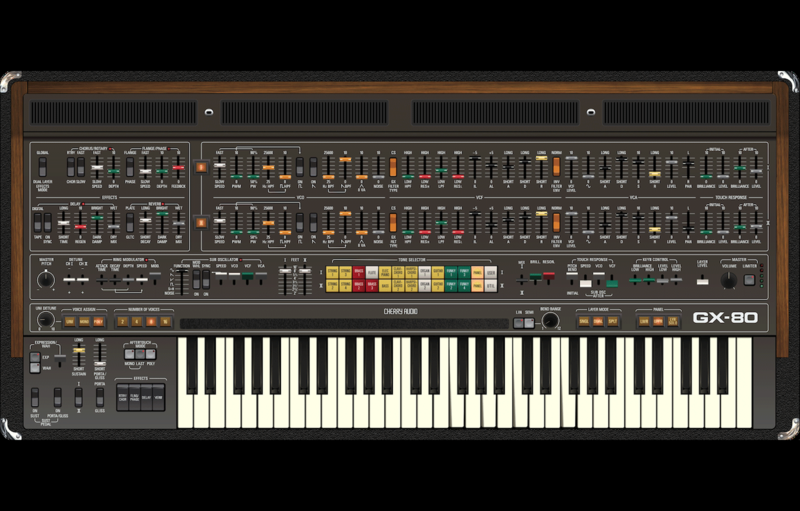 |
GX-80 SynthesizerThe Flagship GX-80 is Cherry Audio’s visionary flagship synthesizer, over a year in the making. Combining the unparalleled sound and features of the fabled GX-1 “Dream Machine” and its renowned descendant, the CS-80 , GX-80 is a transformative virtual synthesizer blending the essence of two groundbreaking instruments to create a powerhouse hybrid. Featuring the carefully crafted and intensely circuit-modeled DSP designs of award-winning developer Mark Barton, Cherry Audio has replicated every subtlety of the classics to create the most authentic emulation of its kind. More than a Replicant GX-80 is not just another CS-80 emulation. GX-80 adeptly reintegrates the GX-1’s distinctive features back into the CS-80 architecture, such as dual synth layers for twice the impact and additional waveforms with variable resonators. The GX-1’s octave-up triangle wave and invert filter envelope control have been reincorporated. Most notably, GX-80 includes an expert reproduct ion of the legendary GX-1 filter that delivers exquisite timbres that even the mighty CS-80 cannot produce. For ultimate flexibility and expressive performance, GX – 80 provides a split keyboard mode and a brilliant option to simulate polyphonic aftertouch with a monophonic aftertouch controller. With its innovative dual-layer interface, stunning sound presets, and integrated studio-quality effects, GX-80 is more than a best-of-both-worlds interpretation of the past and far more than a replicant. Cherry Audio ‘s GX-80 is an unprecedented gateway to the sounds and music of an unrealized future. Unobtainium, Until Now At last count, only a dozen operating GX-1s have been accounted for, and used CS-80s are rarely listed for less than $60,000 . The rarity and exorbi tant cost of both instruments has made it impossible for musicians to experience these legendary instruments. That’s why Cherry Audio is making its flagship GX-80 synthesizer available at the astounding low price that anyone can afford: only $59! GX – 80 Features:
GX – 80 is avai lable in AU, VST, VST3, AAX, and standalone formats macOS Requirements:
Windows Requirements:
|
Price History: GX-80 Synthesizer 59.00 $ |
|
4.72 SOUND QUALITY FEATURES VALUE FOR MONEY EASE OF USE |
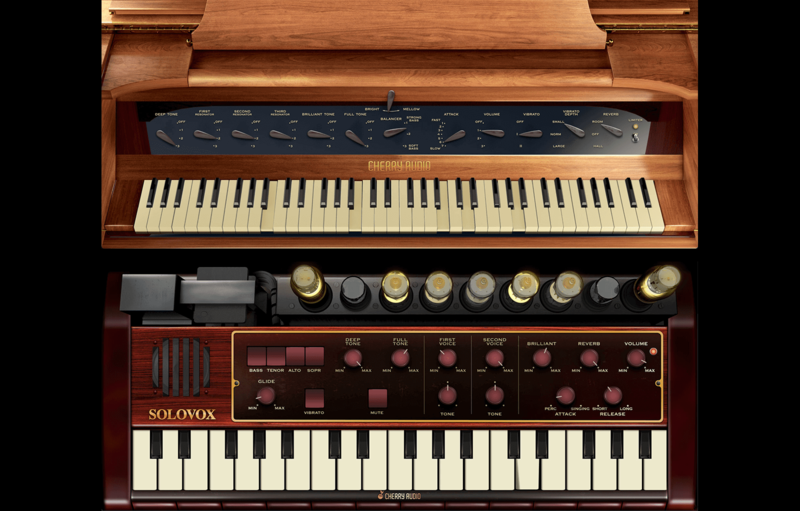 |
Novachord & SolovoxTwo Golden Age Classics, One Low Price The Novachord + Solovox bundle emulates two early electronic instruments that were precursors of modern synthesizers. Novachord is based on the revolutionary polyphonic instrument from 1939, while Solovox replicates a related monophonic keyboard instrument intended to provide organ-style leads. These exceedingly rare instruments set standards for tone generation and synthesis techniques that continue to influence today’s electronic instruments. Novachord + Solovox Features Novachord + Solovox is a bundle of two individual instruments at one low price, provided as one download and installed in both standard DAW/host plugin and standalone formats. Novachord
Solovox
Standard for Both Instruments
Notorious Manufactured by the Hammond company from 1939 to 1942 and debuting at the World’s Fair, the Novachord contained 163 vacuum tubes and over 1,000 custom capacitors. Its divide-down oscillator architecture combined full 72-key polyphony with an early version of analog subtractive synthesis. The Novachord’s architecture predicted the ADSR envelope, utilized a resonant band-pass filter, and included a vibrato unit. These now-familiar methods resemble designs adopted decades later in Moog and ARP polyphonic synthesizers. The Solovox, manufactured by Hammond between 1940 and 1950, was another classic instrument of the era. Based on the Novachord’s oscillator and divider circuits, the Solovox with 18 vacuum-tube Solovox was a small monophonic keyboard instrument attached beneath a piano keyboard and intended to augment it with organ-type lead voices. It consisted of two units: the three-octave mini keyboard, and a tone cabinet for the electronic sound generator, amplifier, and loudspeaker. Like the Clavioline and Ondioline, the Solovox produced a range of string, woodwind, and organ sounds and was widely used in light music from the 1940s and into the 1960s. Unfortunately, the introduction of compact transistor organs released in the 60s marked the end of the Solovox’s popularity. Novachord + Solovox is available in AU, VST, VST3, AAX, and standalone formats (individual for each instrument)
Internet connection required for product activation. |
Price History: Novachord & Solovox 39.00 $ |
|
4.72 SOUND QUALITY FEATURES VALUE FOR MONEY EASE OF USE |
 |
Vintage Voice BundleImportant Note: Voltage Modular is required in order to use this product. Vintage Voice comes fully loaded with SynthVoice, SynthVoice Filter, DCO-60, VCF-60, and Chorus-60 modules. SynthVoice is a complete semi-modular vintage synthesizer, featuring two oscillators, a multi-mode filter, an LFO, dual envelope generators, sample and hold, and spring reverb. It’s like having a classic ARP 2600 synthesizer in your modular rack. SynthVoice Filter delivers the ballsy, pure analog tonality of the ARP 2600 vintage synthesizer. It features lowpass and highpass modes, with selectable 12 or 24 db/oct slopes. DCO-60 models every element of the beloved classic Juno-106 synthesizer, from its self-oscillating filter to its dreamy chorus effect, all combined in a fully-polyphonic module, loaded with patch points, that has to be heard to be believed. Cherry Audio have even recreated the entire “A” bank of original factory presets. VCF-60 is a separate module containing the highpass and lowpass filters from the DCO-60 vintage synthesizer module. With independently patchable sections and a self-resonating lowpass section, it’s the perfect replication of the classic 80’s Juno synth sound. Chorus-60 is an expanded version of the DCO-60 chorus section and precisely replicates the giant, lush stereo spread of classic Roland Juno synthesizers. It adds stereo spread and wet/dry mix controls for added flexibility. Also included in this bundle are a selection of presets designed to explore the raw power of the SynthVoice module, and the beautiful elegance of the DCO-60 module. Note: These presets are designed to work with modules from the Voltage Modular Core package. Voltage Modular is cross-platform for Windows and OSX in AU, VST, VST3, and Pro Tools AAX formats, and also runs standalone on both platforms. User patches and cabinets are freely exchangeable across platforms. Mac
Windows
|
Price History: Vintage Voice Bundle 39.00 $ |
|
4.7 SOUND QUALITY FEATURES VALUE FOR MONEY EASE OF USE |
 |
Rackmode Signal ProcessorsA Monument of Sound Rackmode Signal Processors is a bundle of seven virtual effects and an instrument plugin that replicate the classic rack-mounted Moog Signal Processors of the 1970s and ‘80s. This exclusive collection is the first time this entire line of renowned analog treasures has been recreated as virtual effects. Rackmode also marks Cherry Audio’s latest collaboration with award-winning synth designer and DSP legend Mark Barton (MRB), who modeled the circuit-precise emulations based on the original rack-mounted hardware. The collection includes:
Cherry Audio has expanded these awe-inspiring vintage effects with additional features aimed at today’s music producers, including presets, syncable LFOs, stereo processing, and full Apple Silicon M1 native support. And speaking of authenticity, these effects capture not only the deep sounds and capabilities of the original Signal Processor line, but also the elegant look and heritage of their rack-mounted enclosures. A Stack of Historic Proportions In the late ‘70s and early ‘80s, Moog Music Inc., (then owned by Norlin Music, Inc.) wanted to extend their reach further into the production studio. They created the Signal Processor family of rack-mounted products featuring the 16 Channel Vocoder (designed by pioneer Harald Bode), the 12 Stage Phaser, and the Ten Band Graphic and Three Band Parametric Equalizers. Other related rack products were the Harald Bode-designed Frequency Shifter and Ring Modulator, and the singular String Filter created by Moog’s Custom Engineering Group. The Moog Signal Processors have found a place in production facilities worldwide, both past and present. Artists like Wendy Carlos, Yellow Magic Orchestra, Tangerine Dream, John Carpenter, Genesis, Jan Hammer, Mouse on Mars, and Coldplay have used them to shape their distinctive sounds. And producers as diverse as Giorgio Moroder, Mike Elizondo, and Sylvia Massy have cited these black boxes as treasured parts of their studio gear. Today these units are increasingly scarce and fetch prices far above their original value – that is, if they can be found at all. The Future is Yours Cherry Audio’s Rackmode Signal Processors collection represents a first-time opportunity for producers to explore these studio-quality vintage effects. When combined with today’s modern production workflow, experimentation will lead to inspiration, and an old approach to sound can unexpectedly result in something completely new. If tracked down and purchased today, the original hardware would cost well over $20,000. Cherry Audio is introducing the entire Rackmode Signal Processors bundle at an unheard-of price of $99 (List $129), less than $13 per plugin! MAIN FEATURES
macOS System Requirements:
Windows System Requirements:
Moog® is a registered trademark of Moog Music, Inc. There is no association, affiliation, or endorsement of Cherry Audio or its products by Moog Music, Inc. |
Price History: Rackmode Signal Processors 129.00 $ |
|
4.7 SOUND QUALITY FEATURES VALUE FOR MONEY EASE OF USE |
 |
DreamsynthDreams Brought to Life Cherry Audio’s Dreamsynth is a tribute to the celebrated hybrid analog+digital synthesizers of the mid-to-late 1980s. The innovative design blends flexible dual-wave morphing oscillators, stereo filters, fully polyphonic analog strings, extensive and easy-to-use modulation, studio-quality effects, and MPE support, all in an elegant vintage-style synth interface. An Era of Innovation Dreamsynth draws its inspiration from renowned synths including the Ensoniq ESQ-1, the Kawai “K” series, and the Sequential Prophet VS. In the second half of the ’80s, music production was rapidly transitioning from analog to digital. These “hybrid” synthesizers bridged the gap, combining the precision and flexibility of sampled digital oscillators with the warmth of analog filters. The combination of digital and analog sound produced instruments with character and a unique sonic fingerprint that still resonates today. A Dream Come True With the magic of these vintage classics in mind, we set out to create Dreamsynth. Dreamsynth is a “What if…?” synthesizer incorporating the distinctive qualities of this remarkable era with the best features of modern software instruments to create a uniquely 21st-century hybrid. Dreamsynth Features
AU, VST, VST3, AAX, and standalone formats macOS Requirements:
Windows Requirements:
|
Price History: Dreamsynth 49.00 $ |
|
4.68 SOUND QUALITY FEATURES VALUE FOR MONEY EASE OF USE |
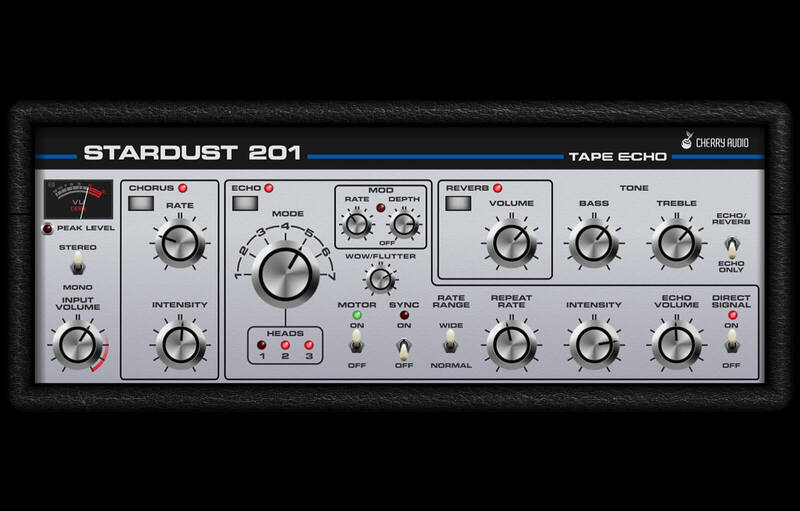 |
Stardust 201 Tape EchoEchoes Of The Past Stardust 201 Tape Echo is a hot-rodded interpretation of the classic Roland “Space Echo” tape echo effects of the 70s and 80s. Compared to earlier tape echoes, they represented a giant leap in reliability and sound quality. With solidly built tape-transport mechanisms and the inclusion of a spring reverb and chorus effects in some models, the Space Echo was truly groundbreaking with its fantastic variety of sound colors. Stardust precisely recreates the limited fidelity and stability of audio tape, providing a natural rolloff of bass and treble frequencies for super-warm tonality and minor speed variances, lending an organic chorusing quality to repeats. Cranking the intensity knob overloads the circuit, generating the other-worldly runaway echoes and feedback that only a tape echo can. Cherry Audio’s Stardust 201 Tape Echo includes features from the original RE-201 and RE-301 Space Echo units, and we’ve added some of our own to create a great-sounding, super-flexible, ideal tape echo effect that never breaks down and never needs demagnetizing, all for less than the price of a Space Echo replacement audio tape loop! Stardust 201 Tape Echo Features:
Stardust 201 Tape Echo is available in AU, VST, VST3, and AAX formats.
|
Price History: Stardust 201 Tape Echo 19.00 $ |
|
4.68 SOUND QUALITY FEATURES VALUE FOR MONEY EASE OF USE |
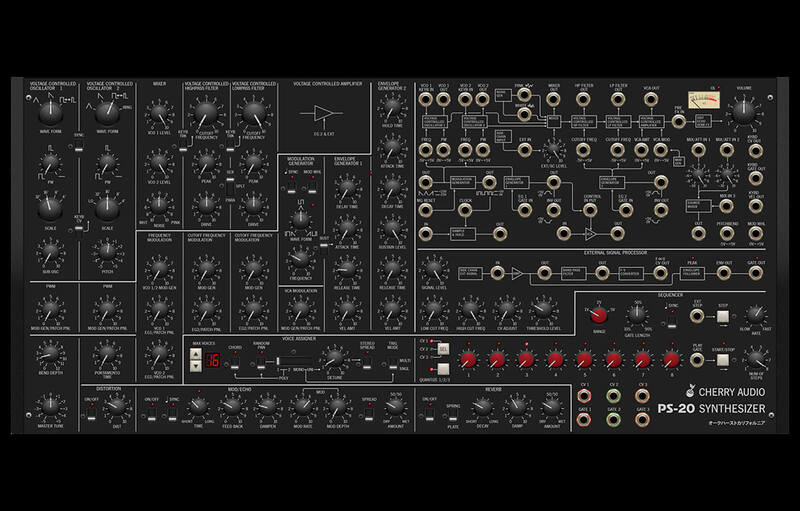 |
PS-20 SynthesizerThe MS Synth Experience, Supercharged PS-20 is an ultra-realistic, polyphonic, hot-rodded tribute to Korg’s renowned MS-20. First and foremost, PS-20’s dual highpass/lowpass filters super accurately recreate the MS-20’s famous raunchy sound in all of its squelchy, screaming glory. In addition to its unique filters, the MS-20’s other signature feature is its modular-style patch panel. We’ve reconfigured the patch panel from the original instrument, adding many desired in and out patch points for all oscillators, filters, and VCAs, correcting the confusing terminology of the original, and throwing in a few extras that greatly expand its usability. Every part of the instrument has been “souped up” with killer features, including 16-note polyphony, a unique three-layer, eight-step sequencer with flexible CV outs, and integrated effects, including a beastly distortion, modulation echo with stereo spread, and a lush digital reverb with fantastic spring and plate emulations. The PS-20 truly is one of the most quirky and unique instruments we’ve released. Between its sometimes unpredictable filter behavior, and the tremendous flexibility of its patch panel and sequencer, the possibilities are endless, and the creative “happy accident” quotient of PS-20 is simply off the charts! PS-20 Synthesizer Features:
Check out the different variations in PS-20 color below: Polymode Synthesizer is available in AU, VST, VST3, AAX, and Standalone formats. macOS Requirements: macOS 10.9 or above
Windows Requirements:
|
Price History: PS-20 Synthesizer 49.00 $ |
|
4.66 SOUND QUALITY FEATURES VALUE FOR MONEY EASE OF USE |
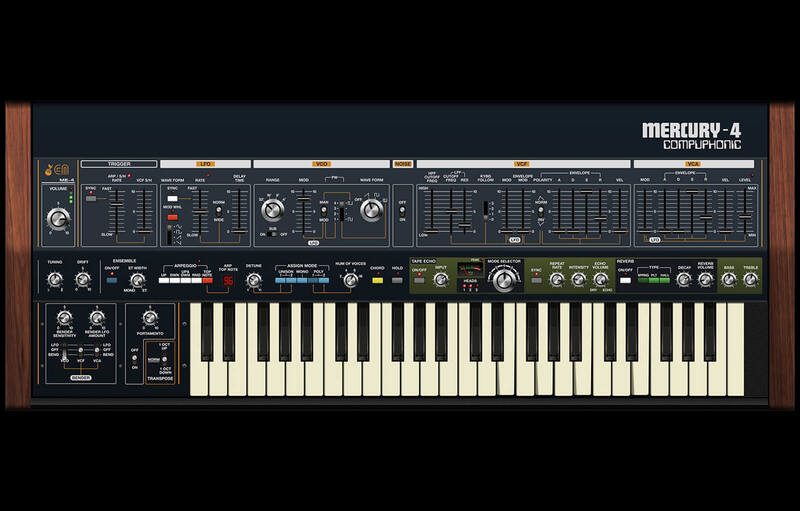 |
Mercury-4Poly In The Beginning Originally released in 1978, the Roland Jupiter-4 synthesizer was one of the earliest instruments to combine voice-assign polyphony with digital patch storage – that is, the ability to store and recall sounds to a digital memory and recall them at the touch of a button. By “voice-assign polyphony,” we’re referring to instruments with a finite number of independent synthesizer voices (four, in this case) that digitally scan the keyboard and assign notes to onboard voices. These days, voice-assign polyphony and digital patch storage are taken for granted, but this was a HUGE deal in the late 70s when options for polyphonic synthesis were mostly limited to crude string synthesizers based upon 60s organ technology, and patch recall was generally limited to how fast you could twirl knobs and flick switches! In its day, the Jupiter-4 was overshadowed by larger, more complex (and far more expensive) instruments from American synth manufacturers, and on paper, its specs weren’t as impressive. But specs don’t tell the whole story, because the Jupiter-4 sounds fantastic, with a raw, raunchy tone not found in any of the other beloved Juno and Jupiter synths. Its analog oscillators have a uniquely aggressive tone quality, the built-in sub oscillator adds girth, its oddly fast and deep LFO modulation capabilities allow it to create uniquely whacked out modular synth-like tones, and Roland’s famous stereo chorus “ensemble” circuit is beautifully implemented, adding a boatload of width and dimension. The original instrument had its share of caveats, including a meager eight user patch locations, no edit mode for stored patches, just four voices of polyphony, it weighed a ton (a portly 42 lb!), and the lack of oscillator autotune meant a cold breeze could send it careening out of tune. Cherry Audio’s Mercury-4 addresses every one of these issues, with up to 16-voice polyphony, infinite patch storage, easy patch editing, and much more. In addition to recreating the Jupiter-4’s uniquely powerful oscillator and filter tonality, Mercury-4 beautifully replicates Roland’s renowned stereo ensemble effect. We’ve also added a truly other-worldly “Space Echo”-style tape echo with multiple reverb modes. The tape echo perfectly recreates the warm tonality and subtle speed variations that make the original Space Echo units so desirable, and the reverb section expands upon the original spring reverb with plate and hall modes for enhanced spatial depth. Mercury-4 Features:
Mercury-4 is available in AU, VST, VST3, AAX, and standalone formats. macOS Requirements: macOS 10.9 or above (including macOS 12), 64-bit required. M1 processor compatible (via Rosetta 2). Quad-core computer with 8GB of RAM recommended. Windows Requirements: Windows 7 or above, 64-bit required. Quad-core computer with 8GB of RAM recommended. |
Price History: Mercury-4 39.00 $ |
|
4.66 SOUND QUALITY FEATURES VALUE FOR MONEY EASE OF USE |
 |
Year One CollectionThe Year One Collection includes all 19 commercial modules that Cherry Audio released in Voltage Modular’s first year. These stellar and innovative modules let you warp and shape your modular sound in crazy new ways. Included Products
Voltage Modular is cross-platform for Windows and OSX in AU, VST, VST3, and Pro Tools AAX formats, and also runs standalone on both platforms. User patches and cabinets are freely exchangeable across platforms. Mac
Windows
|
Price History: Year One Collection 199.00 $ |
|
4.64 SOUND QUALITY FEATURES VALUE FOR MONEY EASE OF USE |
 |
Sines SynthesizerDangerous Curves Ahead Sines is a sensational and innovative original polyphonic synthesizer. Employing four sine-wave oscillators, Sines utilizes diverse waveshaping methods to bend these basic waves into infinitely variable and complex shapes. When combined with its wide-ranging modulation capabilities and effects, users can create a diverse array of unique timbres ranging from the sublime to sizzling The Power of Four The state-of-the-art Sines interface provides immediate hands-on access to all sound parameters. It comes alive with illuminated indicators, color, and mini oscilloscopes, providing instant visual feedback. The primary sound design controls are grouped horizontally in bands emphasizing its “four of everything” nature: four LFOs, four oscillators, and four envelope generators. At the core of each section are the unique sine-wave oscillator waveshaping controls: feedback, phase, width, shape, wavefold, and drive, along with a sub (octave-down)oscillator and a super (octave-up) oscillator. Phase modulation and ratio dials allow the oscillators to be configured in a modulator/carrier arrangement for four-op DX/FM-style synthesis. But these dangerous curves are just the beginning. Sines features Cherry Audio’s most extensive multimode filter to date, four LFOs with 14 wave shapes, four envelope generators, an arpeggio, a “best of” selection of Cherry Audio’s finest acclaimed effects, a drift function, and an integrated eight-band graphic EQ. Many controls include an adjacent modsource button, and an outrageously comprehensive four-slot mod matrix provides numerous modulation options for nearly every Sines parameter. Three Ways to Play Mastering Sines may seem like rocket science, but we’ve made it easy to get started. Sines includes over 500 presets, both practical and cutting-edge, as well as a comprehensive user-guide that’s fun to read. Moreover, the aural and visual immediacy of Sines encourages experimentation and provides a deeper understanding of how the elements interact. In little time, users can design individualized sounds ranging from glorious evolving pads, bright FM plucks, distinctive leads, crisp percussive tones, and much more. Sines lends itself well to three more direct approaches to sound design: standard subtractive synthesis, where sine waves are wave-shaped into other familiar waveforms, then processed through an analog-style filter.Alternately, an additive synthesis approach stacks sine waves at different pitches and Features
Mac
Win
|
Price History: Sines Synthesizer 49.00 $ |
|
4.62 SOUND QUALITY FEATURES VALUE FOR MONEY EASE OF USE |
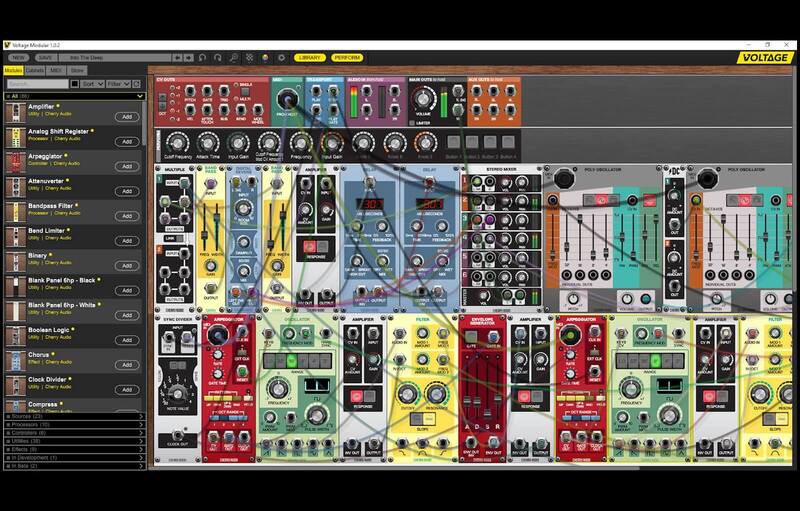 |
Voltage Modular Ignite 2Voltage Modular is a brand-new virtual modular platform. Designed from the outset to be the best sounding, most powerful, flexible, and easy-to-use virtual modular instrument available. Voltage Modular Ignite is a smaller bundle for a smaller price! Get a taste of Voltage Modular with the Ignite module collection. 45 modules and 296 presets are included for the ultimate introduction to modular synthesis. Introducing Voltage Modular 2.0 Cherry Audio is thrilled to announce the highly anticipated release of Voltage Modular 2.0! Voltage Modular 2.0 is the most feature-rich, sonically flexible software modular platform in the world. Voltage Modular 2.0 blows away all patching limitations and introduces groundbreaking new ways to build complex patches with fewer cables. Unlimited cables per jack allow for endless modulation possibilities. The new Busses feature offers an ingenious new way to build complex patches and eliminate messy cables. Variations take modular synthesis in unprecedented new directions, with unlimited variations available per patch. Play variations individually, or use triggers or CV to move through variations in endless ways. The IO panel now includes an integrated Recording section, generating pristine 32-bit floating-point audio files, sourced from the IO Panel main left and right outputs. Workflow improvements are everywhere in Voltage Modular 2.0, from custom module categories and search terms to optional auto-alignment of modules in cabinets. What is Voltage Modular? Unparalleled Workflow Designed from the ground up to address the shortcomings of other virtual modular synth instruments. Featuring six-way pop-up mults on all inputs and outputs, super easy repositioning of modules or groups of modules, cables that can be moved and rerouted at all times, and control panels designed to be easy-to-read and operate with extensive visual feedback, including cable signal flow indicators, Voltage Modular offers a clean, polished, virtual modular interface like no other. Fantastic Sound Quality All audio processing in Voltage Modular uses high-quality 64-bit double-precision math, and all module processes are zero- latency and operate on individual samples for true modular performance. This translates to fantastic sounding audio-rate frequency and amplitude modulation, oscillator sync, insane delay feedback, and more. Infinitely Expandable The innovative module browser allows users to purchase and automatically install modules and sound presets directly from within Voltage Modular for immediate expandability. Features
Voltage Modular is cross-platform for Windows and OSX in AU, VST, VST3, and Pro Tools AAX formats, and also runs standalone on both platforms. User patches and cabinets are freely exchangeable across platforms. Mac
Windows
|
Price History: Voltage Modular Ignite 2 25.00 $ |
Are you a music producer looking for top-quality synthesizers and plugins? Look no further than Cherry Audio! With a wide range of products that are designed to meet the needs of musicians of all levels, Cherry Audio is the perfect choice for anyone who wants to take their music to the next level. From cutting-edge synthesizers to powerful effects plugins, Cherry Audio has everything you need to create professional-quality tracks. So why wait? Buy Cherry Audio at the best price on Soundsmag today and start making music that truly stands out!




































